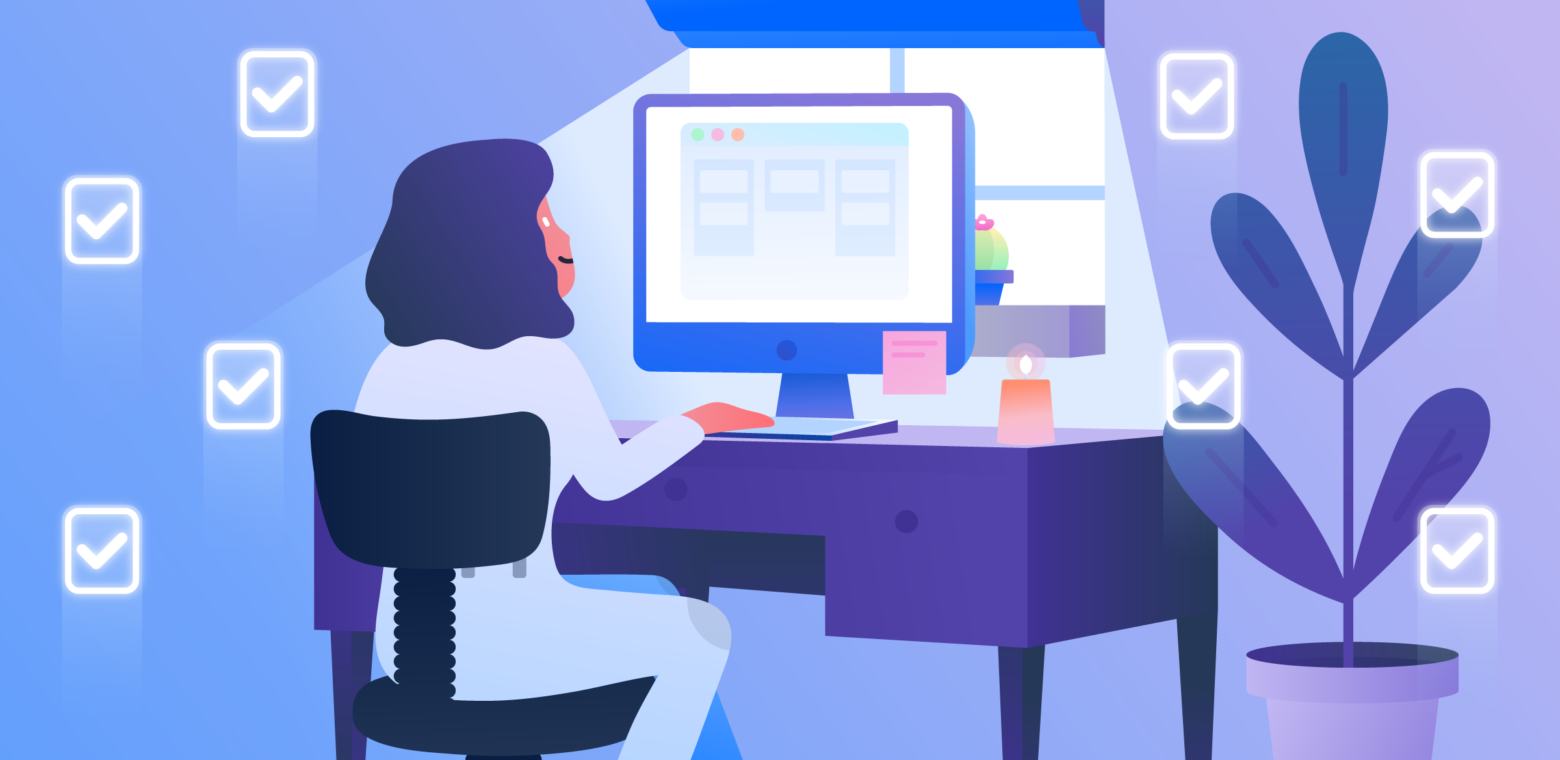Did you recently start working from home? Did your excitement at a ten-second commute quickly turn to dismay, as you watched dirty dishes, crying babies, and general chaos invade your workspace? Is your office really just a laptop on a table—or worse, a couch?
Never fear! You’re not alone, and help is on the way. Remote work has never been more relevant, and while your environment definitely shapes how you work, the good news is that there’s a lot you can do to make sure it helps you work well.
Even if you’ve got limited space, time, or resources, you can create a workspace that looks great, feels great, and helps you produce your best work. Keep reading for some evidence-based tips on how to get there.
Make It Personal
Did you know that working in your own space can actually benefit your productivity? Research has shown that a sense of personalization in your workspace can positively impact happiness and job satisfaction, resulting in a more productive you.
But be careful—just because your workspace is inside your home doesn’t automatically make it personalized. To put this tip into practice, be intentional about setting up and decorating your home office. If you’re jammed into a corner of the living room or surrounded by your kids’ schoolwork, your space isn’t going to feel like yours.
Designate an area (or two) in your home for work, and set them up in an inspiring way. This doesn’t have to be super complicated—think family photos, a vision board, or a print from an artist you love on the wall. To take it a step further, choose objects that you’ll enjoy looking at every day, even functional ones. This could include a beautiful lamp, a vase you keep full of your favorite flowers, or a set of colorful office supplies.
Keep Work and Play Spaces Separate
One of the major challenges of remote work is work-life separation. To maintain your sanity, you’ll need clear boundaries about where and when work happens. Otherwise, you risk plunging yourself into a confusing and distressing state where you’re never fully present at work, but never clocked out, either—truly the worst of both worlds!
To work productively from home, you must minimize distraction. You should make this a priority even if it feels challenging: the research is very clear in that privacy and distraction-free work are crucial to productivity and avoiding burnout.
Even if you’re working with limited resources, you can still carve out your own space. If you aren’t able to commandeer an entire room, orient your desk and chair in a way that promotes separation, and bear in mind where likely sources of distraction in your home could be coming from.
If you’re really tight on space, you’ll need to get a little more creative. Try thinking in terms of time—what hours can you block out when you’re most likely to get peace and quiet? The personalization tip from above comes in handy here, too. In one study, employees working in low-privacy workspaces reported the highest levels of emotional exhaustion—but only if those spaces were generic and impersonal.
Design Your Workspace With Productivity In Mind
Now for the fun part! By getting creative with your space, you can maximize happiness and productivity. The effects of your work environment on mental health and work quality are well-documented, but many employers are only just starting to take the benefits of good office design seriously. When you’re working from home, you can take matters into your own hands!
Light Up Your Life
Light matters. If you’ve ever been trapped in a fluorescent-lit, windowless office, you’ve learned that the hard way. Intuitively, you may already know how much better natural light feels when working, but the science is there to back you up. One study found that natural light reduces eye strain by 51%, drowsiness by 56%, and headaches by 63%—all crucial precursors to feeling your best and doing your best work.

Natural light in your home will vary, but unless you’re working from a subterranean dungeon, you should have access to some kind of natural light. Even if you have to rearrange your furniture to work near a window, it’s worth it to feel happy and healthy where you spend so much of your time. And if you’re lucky enough to have a patio or other outdoor space, try working there when the weather permits for a boost of inspiration and productivity!
Style Matters
By using some psychological tricks, you can tailor your environment to productivity, and even customize it to the type of work that you do! For example, rounded, curvaceous furniture has been shown to evoke feelings of relaxation and calm when compared to objects with sharp edges and corners—so you might want to rethink those trendy, super-modern office chairs!
Interestingly, ceiling height is another way to aid certain types of work. High ceilings tend to promote creative, free-associative thought, while lower ceilings can help with quantitative, analytical processes. On a practical level, this could look like heading to a designated working nook when you need to crunch some numbers, such as underneath a loft bed—or hitting up an airy and well-designed coffee shop when it’s time to get creative.
Bring Nature Inside
Whether it’s indoor plants or a beautiful view, bringing nature into your everyday life is a powerful way to relieve stress and boost productivity. In one study by Washington State University, participants with plants in their workspaces displayed lower blood pressure readings and 12% faster reaction time.
Bringing plants inside is a no-brainer—and while you likely can’t do much to improve the view out your window, there are even easier ways to access the power of nature. Try hanging images of beautiful landscapes in your home office, or even setting them as your desktop wallpaper. It’s not quite the same as a walk in the woods, but there’s research to show that looking at images of nature has relaxing and inspiring effects.

Color Me Productive
Echoing what we’ve found about ceiling height, the colors you surround yourself with can influence the way you think. Recent research shows that different shades can aid in different types of work, finding that red enhances meticulous, detail-oriented tasks while blues support your creativity.
These findings can help you when you’re deciding how to personalize your space. If you’re torn between a painting of a beach or a field of poppies, maybe you should let your job description guide you.
There may also be areas of your home that are already dominated by a certain color. Why not decorate your home office with red fixtures for analyzing data and compiling reports, but when you need to write, head to the desk in your serene blue loft?
Clear Out The Clutter
While a messy workspace is never good, different people benefit from different styles of organization. Depending on your job and working style, you may prefer a hyper-organized workspace, or one that is more fluid without being messy. In particular, some creatives benefit from an element of controlled disorder in their working spaces.

If you’re not sure which end of the spectrum you’re on, test it out! Do you feel more inspired surrounded by the physical aspects of different projects you’re working on (AKA, piles of paper and maybe a few sticky notes), or are you happiest with a cleared-off desk? Do you need a stable, rigid organizational system, or do you prefer just going with the flow?
Whatever type of organization you choose, staying consistent is everything. Get ahead of clutter by having places for all your commonly used objects, like a storage box for cables and a jar to hold loose pens. Also be wary of overly complex systems, as they can end up taking more time to maintain than they’re worth. Often, simple solutions like a two-tray filing system are all you need.
Healthy Spaces Create Productivity
While this may sound obvious, healthy humans do better work. Whether you’re at home or in an office, your environment has an enormous influence on your health, happiness, and general productivity.
Let’s start with the basics—air and water. If the airflow in your apartment isn’t ideal, open up a window to stay alert and energetic. Before reaching for that third cup of coffee when you start to feel tired, keep a pitcher of water or a pot of herbal tea right on your desk so you can stay hydrated without breaking your concentration. By making it easy to give your body what it needs, you’ll stay focused, invigorated, and clear-headed.
If that awkward office chair is killing your back, it’s time to change things up. You can’t perform at your best if you’re constantly shifting around, trying to relax your stiff arms and shoulders. Your desk and chair should be comfortable enough that you don’t even think about them, rather than getting in the way of your concentration.
To avoid sitting for too long, consider a standing desk, or even just working at your kitchen counter for a half-hour every now and then. You can use a box or stack of books to keep your computer at a comfortable height, along with a separate keyboard if that feels best for your neck and wrists. Remember, comfortable spaces are healthy spaces, and that means higher productivity.
A Space That Works For You
Working from home can be a big adjustment, and right now, more workers are experiencing it than ever before. Although remote work has its challenges, it has the potential to be very positive for your job satisfaction and productivity if approached in the right way. Plus, let’s be real—working in an office isn’t always ideal either!
No matter how much time, space, and money you’ve got to work with, these tips will help you create a workspace that feels happy, energizing, and productive. Because you deserve to feel great wherever you’re working from!







































